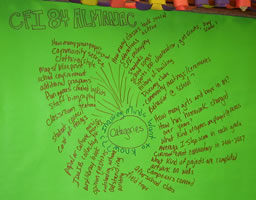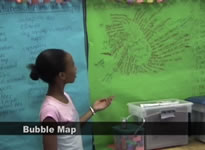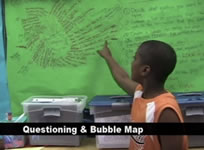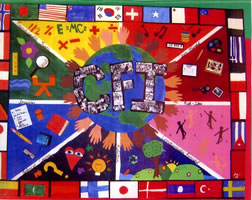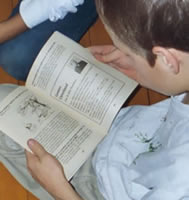 Almanacs and Inquiry:
Almanacs and Inquiry:
School Almanac
After their initial explorations, the children became excited about creating their own school almanac. They wondered how this would be possible and began brainstorming and planning, then creating.
On this page, you'll find students Asking Great Questions, Defining Categories and Gathering Information, Building an Action Plan, Building the Almanac Content, Creating the Almanac Notebook, and Reflection and Thanks.
Asking Great Questions
Before jumping into the creation of a class almanac, the students thought about the types of data and information that might be included in their project. They wondered what their readers would want to know about their school. For instance, does School 84 have any dark mysteries?
What Makes a Great Question
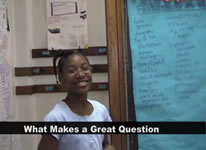 Before brainstorming questions for their class almanac project, Ms. K felt it was important that the children understood the importance of seeking meaningful, useful, and interesting information.
Before brainstorming questions for their class almanac project, Ms. K felt it was important that the children understood the importance of seeking meaningful, useful, and interesting information.
She asked her students to think about what makes a "great question." They came up with the following list of ideas:
- A great question makes you think.
- Something that makes you look in the dictionary.
- Something that takes you years to figure out.
- Not something that can be easily answered.
- A great question needs to make sense.
- A great question is something that you understand
- A great question teaches you more.
- A great question leads to more questions.
- A great question takes you places you’ve never been
- A great question has a point of view.
 View What Makes a Great Question (:22).
View What Makes a Great Question (:22).
A child describes what makes a great question.
A Bubble Map of Opportunities
The class created a bubble map focusing on the following statement: "inquiring minds at CFI want to know [BLANK] about CFI 84." Over the next several weeks, children listed questions that might be answered in their almanac.

 View Bubble Map (1:15) and Questioning and a Bubble Map (:17).
View Bubble Map (1:15) and Questioning and a Bubble Map (:17).
Children describe how a bubble map was used in brainstorming, sharing questions, and organizing assignments.
The bubble map was useful in capturing ideas. Ms. K. noted that the bubble map "will stay on the wall throughout the investigation and be added onto as we go along. The kids like to see their information build over time."
Examples of student questions include:
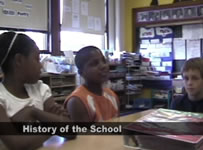 What is the history of this building?
What is the history of this building?- What was the cost of things when this school was built many years ago?
- What is the school song and other traditions?
- Has homework changed to be different today than it was in the early days of this school?
- What are the current community events that involve this School?
- There are many oil and watercolor paintings displayed in the hallways; who painted them and are they famous?
- How many classes and what special things are they doing?
- What do teachers say about the Center for Inquiry philosophy?
- Who are the students of this School? Number of boys and girls?
- What are the after school clubs kids join and which are most popular?
- What were the best field trips this year?
 View History of the School (:17).
View History of the School (:17).
A child describes an interview with a woman who was both a student and teacher at the school.
 Defining Categories and Gathering Information
Defining Categories and Gathering Information
The next phase was to develop categories for research based on the inquiry questions identified by the group.
After determining important categories of interest, the class focused on how to gather the information using surveys, interviews, internet searches, map quests, or other almanacs that might be useful.
 View The Value of Opinion (:22).
View The Value of Opinion (:22).
A child describes the importance of asking people their opinion and gathering different perspectives.
Building an Action Plan
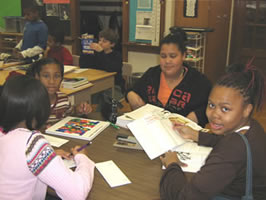 After defining the categories and identifying where to gather information, the young people were ready to action plans for their work as a group or individual. Children discussed their strengths and weaknesses while identifying the roles and tasks required by the project. For instance, some students were confident in their drawing abilities, while others preferred to conduct surveys or interviews.
After defining the categories and identifying where to gather information, the young people were ready to action plans for their work as a group or individual. Children discussed their strengths and weaknesses while identifying the roles and tasks required by the project. For instance, some students were confident in their drawing abilities, while others preferred to conduct surveys or interviews.
The class discussed the importance of working together toward a common goal using the following steps:
- Decide what question you want to explore.
- Generate a list of questions that help get to the information that you want.
- Create a survey, for a certain audience, or interview, research, eye-witness or otherwise investigate.
- Be sure not to disrupt things.
- Gather data and organize it – graph, spreadsheet.
- Analyze the information and look for patterns. So what? Why do I care? What does this mean?
- Put it together in an almanac page with maps, photos, illustrations, bibliographies, and facts.
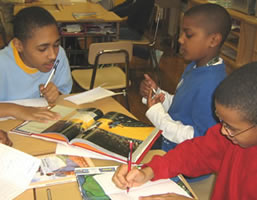 Ms. K. led the whole class in creating an action plan for one category. For example, what are the most favorite clubs offered during discovery clubs? Let's think about who we need to talk to, what we need to research, what we need to create (survey), how we will get information collected and analyzed, and how will we display it to be most visually appealing and informative.
Ms. K. led the whole class in creating an action plan for one category. For example, what are the most favorite clubs offered during discovery clubs? Let's think about who we need to talk to, what we need to research, what we need to create (survey), how we will get information collected and analyzed, and how will we display it to be most visually appealing and informative.
Next, the children broke into small groups and tackled a few categories using the whole group instruction as a guide and reference. They created action plans and met with Ms. K to get final approval. Finally, the students were off making "it" happen.
Some worked quickly and moved onto another category, while others were a little slower. Children could choose what categories to work on giving them some freedom.
Building the Almanac Content
As their work progressed, individual students, pairs, and small groups began creating almanac pages. Most of the pages reflected the features found in the almanacs they explored in their earlier activities. A few of these pages are described below.
Creating the First Almanac Page: The Super Bowl
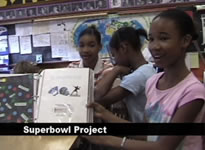 Almanacs often include data collected through interviews and surveys. The class was buzzing about the upcoming Superbowl, so this event become a popular topic for the almanac.
Almanacs often include data collected through interviews and surveys. The class was buzzing about the upcoming Superbowl, so this event become a popular topic for the almanac.
A small group worked on creating surveys about the Colts football team and the Superbowl.
The surveys were then circulated throughout the day. The children used the data to document this event in history as their first almanac piece. Their documentation including charts and graphs, along with narrative.
According to their findings, the most popular food students consumed while watching the Colts win the Super Bowl was cookies with soft drinks.
 View Superbowl Project (:11).
View Superbowl Project (:11).
A child describes the process of collecting and reporting data related to Superbowl.
CFI Mural as Almanac Cover
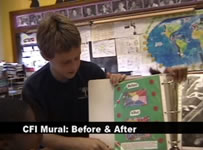 The students wanted the cover of the almanac to reflect their philosophy of learning as well as the contents of the almanac. Four students worked collaboratively to create the CFI mural used for the cover of the school almanac.
The students wanted the cover of the almanac to reflect their philosophy of learning as well as the contents of the almanac. Four students worked collaboratively to create the CFI mural used for the cover of the school almanac.
Timelines are often found in almanacs, so the students created an almanac page showing an early version and final version of the design. Then, described the process and thinking that went into the creation of the mural.
 View CFI Mural: Before and After (:51).
View CFI Mural: Before and After (:51).
A child describes the process of creating the CFI mural on the front cover of the class almanac.
Special Classes
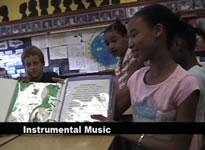 The students wanted to highlight special classes such as instrumental music.
The students wanted to highlight special classes such as instrumental music.
In addition to describing the class, they also featured their experience at the VH1 concert.
They noted that in their survey the most popular special class at the Center for Inquiry is an instrumental music class on string instruments such as violin, cello, viola, and bass.
 View Instrumental Music Class (:50).
View Instrumental Music Class (:50).
A child describes the instrumental music class page.
CFI Goals
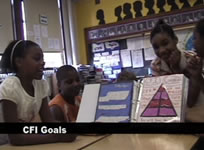 One child chose to focus on the goals of the school.
One child chose to focus on the goals of the school.
She created a pyramid highlighting the elements of an effective school including:
- You will enter and will welcome to CFI
- We can walk in peace and come together as one.
- We work all together. We do our best.
- We work as a community. Share thoughts with one another.
- We can care of each other.
- We can share ideas.
- Love and peace.
 View CFI Goals (1:02).
View CFI Goals (1:02).
A child describes the goals of the school.
Classroom Disaster News
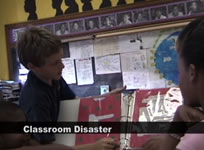 A classroom disaster down the hall was highlighted as a special event or news item.
A classroom disaster down the hall was highlighted as a special event or news item.
According to the student reporter, Ms. Shockely’s class was trashed, but the teacher and the students worked together to clean up the mess.
 View Classroom Disaster (:49).
View Classroom Disaster (:49).
A child describes the classroom disaster activity down the hall.
Happy Teacher Week
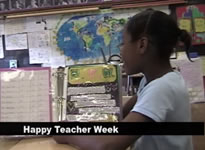 Almanacs often focus on special events. One students decided to celebrate with a Happy Teacher Week page to highlight activities related to Teacher Appreciation Week.
Almanacs often focus on special events. One students decided to celebrate with a Happy Teacher Week page to highlight activities related to Teacher Appreciation Week.
She included the purpose of the celebration, what makes a good teacher, and quotes from her teacher.
 View Happy Teacher Week (:39).
View Happy Teacher Week (:39).
A child describes her almanac page called Happy Teacher Week.
Science Camp
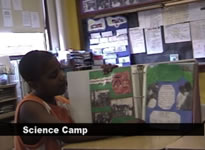 The class participated in a Science Camps sponsored by IUPUI.
The class participated in a Science Camps sponsored by IUPUI.
The children created an almanac page to feature the experience and the science activity stations.
They noted that at Science Camp they made model cars and learned the carbon cycle.
 View Science Camp (:56).
View Science Camp (:56).
A child describes science camp.
Boy's Basketball Page
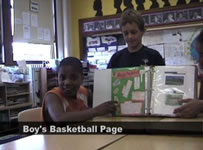 Many of the children enjoyed the sports almanacs and explored how statistics and other information was conveyed.
Many of the children enjoyed the sports almanacs and explored how statistics and other information was conveyed.
Two boys created a page for the boy's basketball team including names of players, background information, statistics, and interviews with fans.
They noted the scoring point averages in boy’s basketball were Edward 6, DeLorean 6, Raylon 6, Antonio 3, Tristen 4, Ernest 4, DeShawn 2, and Mark 2.
 View Boy's Basketball Video (:27).
View Boy's Basketball Video (:27).
A child describes a page he and his partner created on the boy's basketball team.
School Songs
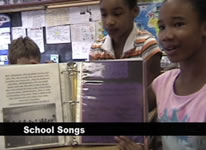 The class highlighted the school song and also featured their own songs.
The class highlighted the school song and also featured their own songs.
The almanac page features the lyrics and photographs of singing the songs.
 View School Songs (:38).
View School Songs (:38).
A child describes the school songs page.
School Building
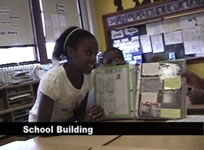 A series of almanac pages focused on the school building facilities.
A series of almanac pages focused on the school building facilities.
The children included the floorplan, photos from a field trip, and explanations of the workings of the broiler and other mechanics aspects of the building facilities.
They also provided basic facts about the building operation. For example, it takes three people, 120 man hours a week to run this building.
 View School Building (:38).
View School Building (:38).
A child describes the school facilities through history.
Student Council Page
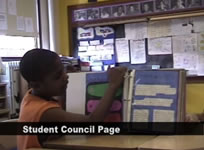 Many almanacs contain pages on organizations.
Many almanacs contain pages on organizations.
The students concluded that student opinions on the purpose of Student Council vary greatly, but most members believe they are doing fine
 View Student Council Page (1:20).
View Student Council Page (1:20).
A child describes the student council page.
Favorite Book Poll
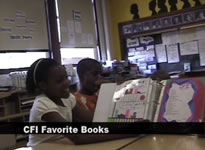 Almanacs often include polls showing favorite things. One group decided to create a poll of favorite books.
Almanacs often include polls showing favorite things. One group decided to create a poll of favorite books.
The results of their poll showed the all-time favorite books of CFI students were The Lorax, Where the Sidewalk Ends, Love that Dog, The Chocolate Boy, and Harry Potter.
They conducted polls on other topics. For example, the three most popular indoor games for CFI students are Monopoly, chess and battleships.
 View CFI Favorite Books (:33).
View CFI Favorite Books (:33).
A child describes the process of collecting and reporting data related to CFI favorite books.
Teacher Interviews
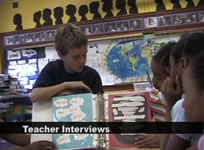 Interviews are often found in almanacs.
Interviews are often found in almanacs.
Two students decided to interview four of their teachers on a wide range of topics.
The results of the interviews were displayed in a comic-type format with bubbles for questions and answers.
 View Teacher Interviews (1:10). Also view Teacher Interview Results (:31).
View Teacher Interviews (1:10). Also view Teacher Interview Results (:31).
A child describes the process he and his partner used to interview four teachers and report their results.
Quotes and Advice from Kids
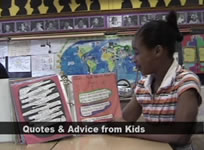 Students discovered that any almanacs contain quotes from famous people or advice on a wide range of topics from cooking to travel.
Students discovered that any almanacs contain quotes from famous people or advice on a wide range of topics from cooking to travel.
One child interviewed young people and ask about their advice to others. The result was a wonderful list of quotes and advice from kids to other kids. She also incorporated some of her own favorite quotes found in almanacs. A few quotes include:
- Things turn out best for the people who make the best out of they way things turn out.
- Character is doing the right thing even when no one is looking.
- You never know what you can do until you try.
 View Quotes and Advice from Kids (:37).
View Quotes and Advice from Kids (:37).
A child describes the process of interviewing children and exploring almanacs for quotes and advice.
Culture Study Map
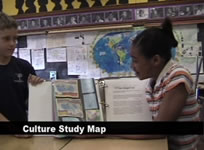 The class connected their culture study with their almanac by incorporating photographs of their wall map and a description of the elements.
The class connected their culture study with their almanac by incorporating photographs of their wall map and a description of the elements.
Maps are a common feature of almanacs. The students studied the elements of maps and discussed the elements that should be included such as identification of governments, cultures, populations, biomes, and poverty. They also provided a key.
Learn more about the Culture Study aspect of the project.
 View Culture Study Map (1:09).
View Culture Study Map (1:09).
A child describes the culture study map included in the class almanac.
Creating the Almanac Notebook
Over the next four months, the class almanac continued to evolve. Students worked on editing and refining the articles.
During the last month of school, the class assembled the almanac into a single, 80 page three-ring notebook containing drawings, photographs, charts, maps, and narratives.
The paper-based notebook was digitized.
Click the notebook photograph on the left or the link to read the electronic book version. Use the PREVIOUS and NEXT buttons below each visual to move through the pages.

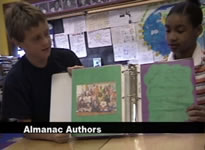 View Almanac Authors (:28).
View Almanac Authors (:28).
A child describes the authors of the School almanac.
Reflections and Thanks
In their reflections, several students noted that future classes would be able to build on their work. They hoped that their efforts would help a new group of students produce the Second Annual School Almanac.

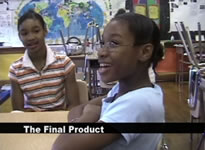 View The Final Product (:11).
View The Final Product (:11).
A child describes her amazement at the final product.
"Student contributors to the School 84 Almanac agree that the Center for Inquiry has provided them with the opportunity to gain confidence, to read and write more than before and enjoy it, and to be a critical questioner" [1].

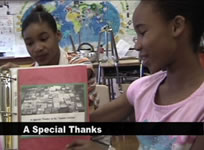 View A Special Thanks (:16).
View A Special Thanks (:16).
A child describes a page created to thank Dr. Callison for his work with the project.
Go to the Personal Inquiries page to learn more about the next phase of the project.

